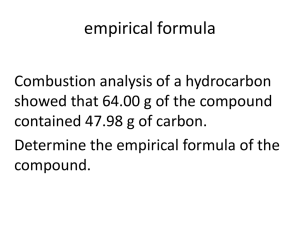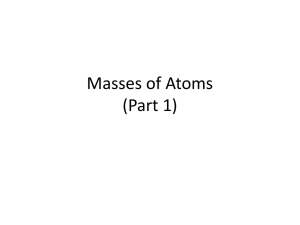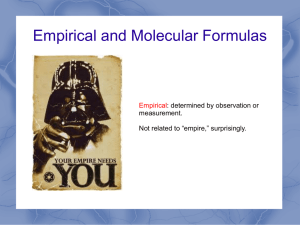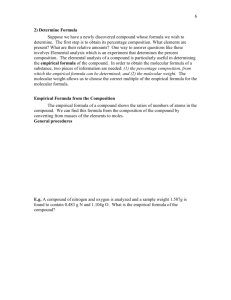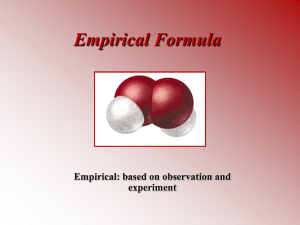1 mole Fe - Salem Community Schools
advertisement
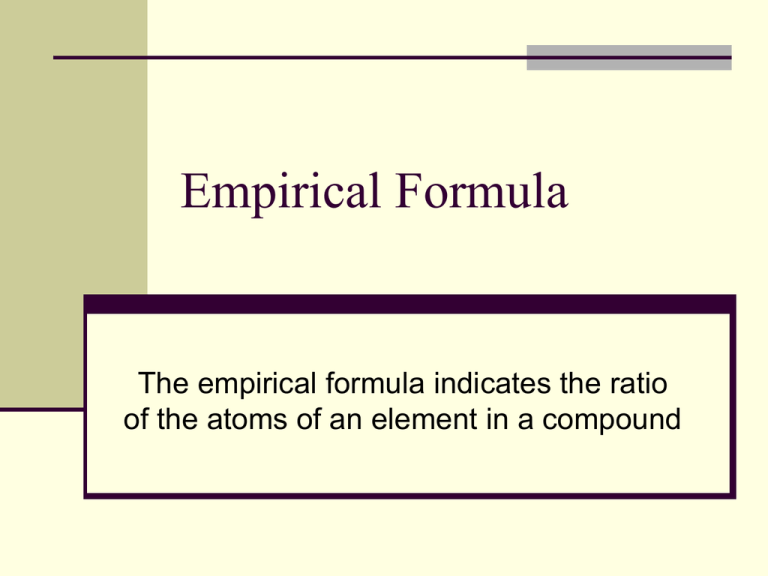
Empirical Formula The empirical formula indicates the ratio of the atoms of an element in a compound Empirical Formula The molecular formula of a compound indicates how many moles of each element are in 1 mole of the compound. For example: Glucose is C6H12O6. How many moles of carbon are in 1 mole of glucose? CORRECT There are 6 moles of carbon in 1 mole of glucose because of the subscript 6 after the C in the formula. Now look at the ratio of the atoms in glucose. Glucose is C6H12O6. The ratio of atom is C1H2O1. Therefore the empirical formula is CH2O. PRACTICE What is the empirical formula of C6H12? CH2 What is the empirical formula of C6H6? CH Empirical Formula We will now learn how to calculate an empirical formula from experimental data. For example: We have a compound that has 70% iron and 30% oxygen. It is easiest to assume we have a 100g sample of the compound. Let’s begin. Step #1 Calculate the number of grams of each element in 100g of the compound. 70% iron is 70g of iron 30% oxygen is 30g of oxygen Step #2 – Convert grams to moles Convert grams to moles 70g Fe 1 mole Fe 55.8g Fe 30g O 1 mole O 16.0 g O 1.25 moles Fe 1.87 moles O Fe1.25O1.87 – That’s strange looking Our last calculation showed that the ratio of the elements in the compound is 1.25 moles of iron to 1.87 moles of oxygen. Chemical formulas use whole numbers to show the ratio of the elements in a compound Our next step is to convert to the lowest whole number ratio for the formula. Step #3 Divide each number by the smallest number. 1.25 moles Fe 1 moles Fe 1.25 1.87 moles O 1.25 1.5 moles O Problem? Our results did not give us a whole number ratio. Most of the time, step #3 will yield whole number ratios, but occaisionally you will have to go on to step #4. Step #4 If necessary, multiply by a factor so that all of the numbers are whole numbers. Since the mole ratio in the problem is 1:1.5, multiply by numbers by 2. 1 mole Fe x 2 = 2 moles Fe 1.5 moles O x 2 = 3 moles O Final Answer: Fe2O3 Congratulations, you can determine an empirical formula from experimental data. Now, let’s learn how to determine the MOLECULAR FORMULA from the empirical formula. Remember, the empirical formula is the lowest whole number ratio, the MOLECULAR FORMULA is the actual formula of the compound Determine the Molecular Formula Example Problem: Given a compound with an empirical formula of CH2 and a molecular mass of 42, what is the Molecular Formula? Step #1 Calculate the mass of the empirical formula. CH2 is composed of one carbon atom and two hydrogen atoms. Therefore the molecular mass is 14.0g. Step #2 Divide the molecular mass by the empirical mass. 42g 14g 3 This is the mass ratio. Step #3 Multiply the subscripts of the empirical formula by the mass ratio. CH2 X 3 = C3H6 The molecular formula is C3H6


